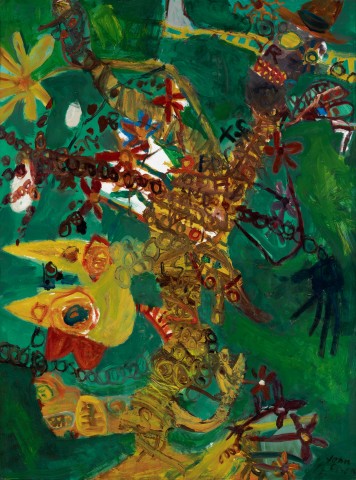CHILD'S SEVENTH BIRTHDAY, 1962
JOHN OLSEN
oil on composition board
122.0 x 92.0 cm
signed and dated lower right: John Olsen 62
bears inscription with title verso: CHILDS / SEVENTH / BIRTHDAY / 3 /
To Clunes / By Transport / JOHN OLSEN / CLUNE GALLERIES / SYDNEY
Terry Clune Galleries, Sydney
Anthony and Sandra McGrath, Sydney, acquired from the above in 1963
Rudy Komon Gallery, Sydney
Private collection, Sydney
Recent Paintings, Gouaches & Drawings by John Olsen, Terry Clune Galleries, Sydney, 6 March 1963, cat. 11 (kindly lent by Mrs Tony McGrath)
John Olsen: Recent Paintings, Australian Galleries, Melbourne, 1 – 18 October 1963, cat. 3
Spate, V., John Olsen, Georgian House, Melbourne, 1963, pl. 31 (illus.), p. 19
In a review of Olsen’s 1963 exhibition at Terry Clune Gallery, which included the key Olsen works from the early 1960’s, including Child’s Seventh Birthday, 1962, Daniel Thomas wrote ‘…Olsen’s city pictures are full of humanity and conversation… Such work makes nonsense of any distinction between abstract and figurative art, and Olsen’s special significance at present in Australian painting is that he has been right through abstraction and come the other side… There is a world of difference between such confident assurance and the timidities of semi-abstract art.’1
As Thomas says, a distinctive quality of Olsen’s work is its conversational nature. The works tell and show us a story; whether it’s a landscape, a portrait or an event, they become a detailed mud map of that event in paint. The works’ meandering lines come across as rollicking yarns rich in anecdote and detail. There is a genuine three-way conversation between Olsen, his subject and his materials, and out of this synergy his images are distilled. Child’s Seventh Birthday, 1962, conveys the wanton joy of a child’s birthday – indeed, few things live as large in a happy child’s imagination as an approaching birthday party, they are major childhood events that are etched in their memory. The joie de vivre of the event as imagined by the child, through the eyes of the artist is expressed here in line, colour, form and atmosphere, as the artist and his materials party on the surface.
In many ways, Olsen’s life and his art are inseparable. His oeuvre represents the cumulative response of an artist’s life experiences, its people and their attitudes towards life and art. The present work belongs to an extremely important time in the artist’ life. He had returned from a three-year sojourn in Spain, where he absorbed the works of masters from Goya to Tapiès. Now resettled back in Australia he was ready to challenge trends in the local painting of the day. The works from this inspired, energetic period formed the cornerstones of Olsen’s career and provided the springboard from which the artist launched himself into the centre of Australian painting. Acclaim quickly followed, and conservative critics were swept aside as the baton was passed from Passmore to Olsen and he became the Pied Piper for progressive Sydney painting.
In 1963 Virginia Spate published the first monograph on the artist. Included amongst the paintings illustrated are important examples such as Up and Down the Sea Port, 1961 (Art Gallery of Western Australia); Journey into The Beaut Country No.1, 1962, (National Gallery of Australia); Journey into The Beaut Country, 1962 (Queensland Art Gallery I Gallery of Modern Art); Spanish Encounter, 1960 and Australian Flux, 1960 (both in the collection of the Art Gallery of New South Wales). Along with the major the institutions cited, many of the private collectors of the works listed in Spate reflect the cultural elite of the time. Curators, critics, taste makers and influential collectors such as Daniel Thomas, Robert Hughes, James Fairfax, Mervyn Horton, Leslie Walford, Clement Meadmore each acquired works from this formative period of the artist’s career. Child’s Seventh Birthday, 1962, was loaned for the 1963 exhibition by Anthony and Sandra McGrath, the latter being the art critic for The Australian during the 70s and 80s, and author of the definitive 1978 monograph on Brett Whiteley. The prestige of these institutions and private collections underscore the importance of the early 1960s works, not only to Olsen but to our artistic language as a nation. Olsen painted the way Australian’s talked, behaved and expressed themselves. Few in number and tightly held, these paintings represent an exciting time in Australian art, when the wunderkind of 1950s Sydney painting came of age.
1 Thomas, D., The Week in Art, Telegraph, Sydney, 17 March 1963
HENRY MULHOLLAND
